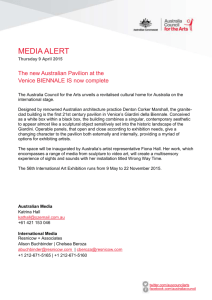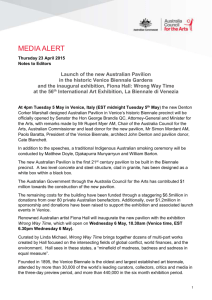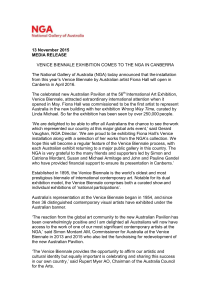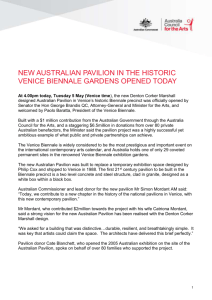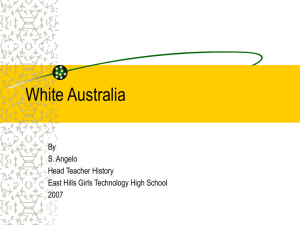Document - Australia Council for the Arts
advertisement
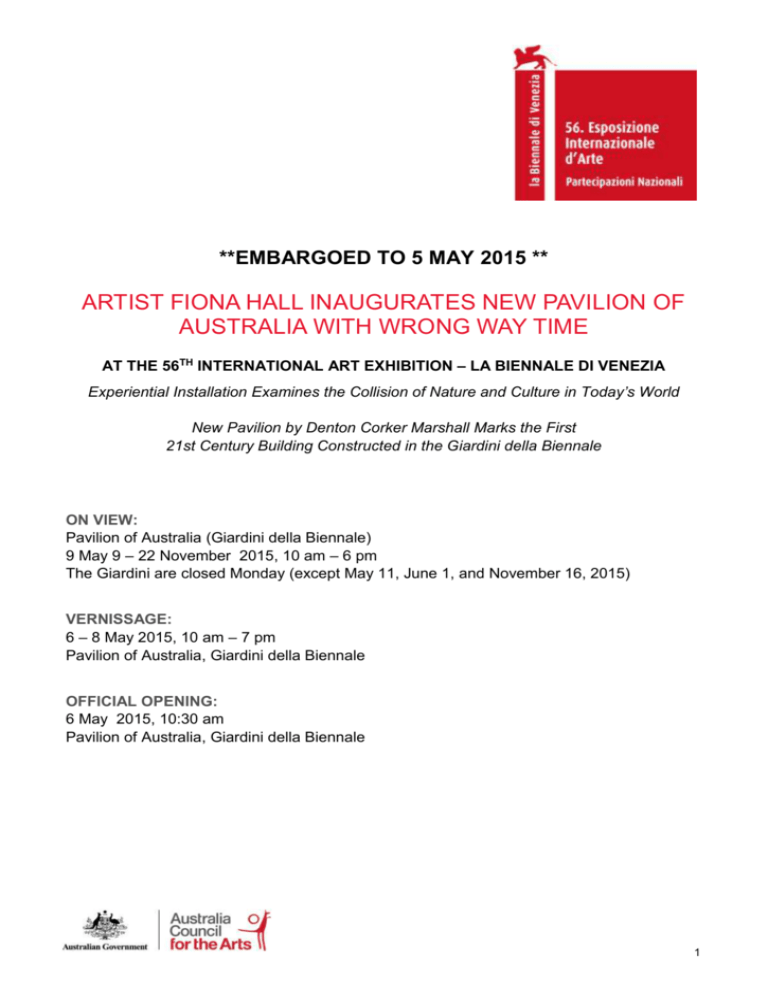
**EMBARGOED TO 5 MAY 2015 ** ARTIST FIONA HALL INAUGURATES NEW PAVILION OF AUSTRALIA WITH WRONG WAY TIME AT THE 56TH INTERNATIONAL ART EXHIBITION – LA BIENNALE DI VENEZIA Experiential Installation Examines the Collision of Nature and Culture in Today’s World New Pavilion by Denton Corker Marshall Marks the First 21st Century Building Constructed in the Giardini della Biennale ON VIEW: Pavilion of Australia (Giardini della Biennale) 9 May 9 – 22 November 2015, 10 am – 6 pm The Giardini are closed Monday (except May 11, June 1, and November 16, 2015) VERNISSAGE: 6 – 8 May 2015, 10 am – 7 pm Pavilion of Australia, Giardini della Biennale OFFICIAL OPENING: 6 May 2015, 10:30 am Pavilion of Australia, Giardini della Biennale 1 VENICE, Italy, 5 May 2015—Wrong Way Time brings together dozens of multi-part works created by artist Fiona Hall, set in dialogue with each other within a multisensory, immersive display. Hall’s subject is the intersecting field of global conflict, world finances, and the environment, which she perceives as “a minefield of madness, badness, and sadness in equal measure”. Her sustained examination of the intricate interrelationship between nature and culture takes on new urgency as she responds to the realities of climate change, war and increasing inequity. A veritable museum of transformed materials and objects, together with intense and poignant paintings and sculptures, prompt us to consider our impact on the future of nature. Hall is the first artist representative to exhibit in the new Pavilion of Australia, designed by Australian architecture firm Denton Corker Marshall, and managed by the Australia Council for the Arts —the first 21st century and only water-facing pavilion in the historic Giardini della Biennale. “Wrong Way Time strongly resonates with the 56th Biennale di Venezia curator Okwui Enwezor’s call to ‘offer the world a global sounding board,’ and serves as a timely and powerful survey of the state of our world,” said Simon Mordant AM, Commissioner for the Pavilion of Australia. “Hall has long focused on the increasing urgency of these issues and I am delighted that she has been given such a platform to take stock of our contemporary age.” “The realities of terrorism, war, climate change, environmental pillage, and economic turmoil have become part of our daily consciousness,” said Hall, the artist representative for the Pavilion of Australia at the 56th International Art Exhibition—La Biennale di Venezia. “Our contemporary mindset has resulted in widespread paranoia over this perilous state. But it’s a world that’s also resilient and wondrous. The body of work I'm presenting is a personal attempt to reconcile a state of gloom and chaos with a curiosity and affection for the place where we all live.” In Wrong Way Time, visitors enter a dark space where illuminated objects emerge from the shadows. A forest of painted clocks—grandfather, grandmother, mantle, and cuckoo – forms a dark wall of lament along one side. Charred cabinets are filled with collections of banknotes, newspapers and atlases and other archaeological remnants of contemporary life, along with cast bronze forms and intricate hammered tin sculptures, sculpted bread, live spiders that spin webs over landscape dioramas, and bird’s nests made of shredded banknotes. The cabinet surrounds a central group of hanging figures with distorted heads knitted from camouflage fabric, a nihilistic hub of hollow death masks. The intermittent sounds of clocks ticking, chiming and cuckooing, along with field recordings of crows, add a resonant layer that contributes to a sense of madness and doom. “Hall’s encyclopaedic installation is her response to the condition of living on this planet, a contemporary vision of heaven and hell. It conveys her deep love of the world in all its variety, complexity and wonder, and her alarm at the ignorance and greed that threatens its existence,” said Linda Michael, the exhibition curator. “The title Wrong Way Time is both a verdict and a challenge. While it reflects a pervasive sense of uncertainty about the future, fed by news about war, climate mutations, species extinction and economic inequity, the exhibition itself is life-affirming and transformative.” 2 Wrong Way Time can be read as a body of work encompassing hundreds of elements, each embedded with layers of meaning that the viewer discovers while navigating through the exhibition. Hall uses repetition, mimicry, layers of reference, and repurposed materials and objects to create a symbolic landscape that reveals her fascination with natural cycles, and the policies and actions that degrade organic systems or diminish life. This is evident in Tender (2003–06), a collection of more than 80 nests painstakingly created from shredded U.S. dollar bills. While these sculptures accurately capture a range of avian structures, underscoring the diversity found in the natural world, their emptiness brings attention to the loss of species and habitats. Tender also prompts questions about the value of currency by rendering it worthless through the act of shredding, and asks us to consider what our society nurtures in its relentless pursuit of profit. The impact of colonization and capitalism on the environment is also explored in Manuhiri (Travellers) (2014), for which Hall collected driftwood, including pine, poplar, manuka, and kanuka, from the Waiapu River on the east coast of the North Island of Aotearoa New Zealand. The Waiapu was once surrounded by heavily forested land before suffering from erosion, chemical runoff, and the accumulation of silt due to development. In a paradoxical and poetic move, the pieces of driftwood selected by Hall evoke the shape of living creatures, appearing as poignant vestiges of the environmental degradation that shaped them. All the King’s Men (2014–15) is a display of hanging, three-dimensional figures whose heads are knitted from uniforms made of camouflage fabric from various countries, designed to mimic nature to benefit the activities of military forces. Ghostly vestigial bodies hang from the disfigured heads, forming a disturbing group that stands in for countless foot-soldiers, casualties of war regardless of nationality. Camouflage appears again in Kuka Iritija (Animals from Another Time) (2014), a collaboration with eleven artists from the Tjanpi Desert Weavers, a collective of Aboriginal women artists known for their works of fiber art created from weaving tjanpi, or grass. To realize this work, both Hall and the women wove extinct and endangered animals native to Central Australia out of indigenous desert grasses. The process of creating these forms and their culminating presentation in Venice preserves the memory of creatures that roamed the land before the effects of climate change and feral animals took hold, or covert nuclear bombings carried out by the British in the 1950s in Maralinga rendered some parts of this area uninhabitable. For Kuka Iritija, Hall supplied the women with strips of fabric from contemporary British and Australian military uniforms to weave into their creatures, thereby inserting the narrative of the loss and displacement of Aboriginal people under colonial rule. 3 ABOUT THE ARTIST Fiona Hall (b. 1953, Oatley, Sydney, Australia) lives and works in Adelaide. Producing mainly photographic works in the 1970s, she extended her creative practice in the 1980s to embrace a diverse range of media including painting, sculpture, installation, garden design, and film. Transforming everyday materials and objects, Hall creates artworks that often address the relationship between nature and culture. Her practice includes major public commissions and projects that have increasingly engaged with themes of ecology, history, and the effects of globalisation. The recipient of numerous honours and awards, Hall’s most recent solo exhibitions include Fiona Hall: Big Game Hunting at the Heide Museum of Modern Art, Melbourne, (2013); a major survey exhibition, Fiona Hall: Force Field, held by the Museum of Contemporary Art Australia, (2008), in partnership with City Gallery Wellington, New Zealand; and the retrospective exhibition The Art of Fiona Hall, at Queensland Art Gallery, Brisbane, which toured to the Art Gallery of South Australia, Adelaide (2005). ABOUT THE NEW AUSTRALIAN PAVILION Wrong Way Time inaugurates the new Pavilion of Australia, designed by Denton Corker Marshall and managed by the Australia Council for the Arts. This is the first 21st-century building and only water-facing pavilion to be built in the historic Giardini della Biennale. The new Pavilion of Australia is in contrast against the Venice skyline with its black granite exterior and stark geometric silhouette. Large-scale operable panels on the exterior of the building can be lifted, allowing natural light to stream through the exhibition space and offering pavilion visitors views of the canal. The interior of the building is a 240m2 rectangular, almost square gallery, whose flexible format can be transformed in accordance to the multifaceted needs of installing work by contemporary artists. ABOUT THE CURATOR AND COMMISSIONER Linda Michael is the Curator for the Australian exhibition at the 2015 Biennale di Venezia. She is a leading expert on contemporary Australian art and is currently Deputy Director and Senior Curator at the Heide Museum of Modern Art, Melbourne. At the 2003 Biennale di Venezia, she curated Patricia Piccinini’s exhibition We Are Family for the Pavilion of Australia. Michael’s many exhibitions include: Future Primitive (2013), Callum Morton: In Memoriam (2011), and Freehand: Recent Australian Drawing (2010), at Heide Museum of Modern Art, Melbourne; 21st Century Modern: The Adelaide Biennial of Contemporary Australian Art (2006); and numerous exhibitions at the Museum of Contemporary Art Australia, Sydney, including Mikala Dwyer (2000), word: artists explore the power of a single word (1999), and Real Fictions: Four Canadian Artists (1996). She also served as the Australian Commissioner for Song of the Earth at the Museum Fridericianum in Kassel, Germany in 2000. Simon Mordant AM is the Commissioner for the Australian Pavilion at the 2015 Biennale di Venezia, and also served as Commissioner in 2013. He has been Chairman of the Board of the Museum of Contemporary Art Australia since 2010, and served previously as Chairman 4 of the Museum’s Foundation. Simon also sits on the Board of the Australian Broadcasting Corporation (ABC), Garvan Research Foundation, MOMA PS1, the Leadership Council for the New Museum in New York, and is a member of the Executive Committee of the Tate International Council and a member of the International Council of The Museum of Modern Art in New York (MOMA). He is also an Advisory Board member to Venetian Heritage in Italy. EXHIBITION CATALOGUE AND PUBLIC PROGRAMS Fiona Hall: Wrong Way Time Australia Council for the Arts & Piper Press, Linda Michael (ed.), Sydney, 2015 Essays by Linda Michael and David Hansen, and an interview with the Tjanpi Desert Weavers 136 pages, hardback, 280 x 224 mm, fully illustrated in colour ABOUT DENTON CORKER MARSHALL One of Australia’s most highly regarded architecture firms, Denton Corker Marshall was unanimously selected to design the new pavilion from a short list of six Australian firms. Denton Corker Marshall is known for such landmark buildings as the Stonehenge Visitor Centre in the United Kingdom, the Australian Embassies in Tokyo and Beijing, the Melbourne Museum, and the Museum of Sydney. Established in Melbourne in 1972, the firm was founded by architects John Denton, Bill Corker, and Barrie Marshall. With additional practices in London, Manchester, and Jakarta, Denton Corker Marshall has earned acclaim for its functional designs and approach to creating memorable architecture that distills and refines a principal, singular idea. Among the awards they have garnered are the Australian Institute of Architects National Award for Residential Architecture for Zinc House (2011); RIBA National Award and Sustainability Award for the Manchester Civil Justice Centre (2008); and RAIA Victorian Architecture Medal, Project of the Year for the Melbourne Museum (2001). ABOUT AUSTRALIA AT LA BIENNALE DI VENEZIA Australia has been represented at la Biennale di Venezia since 1954. In the 1980s Australia secured the then-last available location within the Giardini, and in 1988 opened a temporary pavilion designed by Philip Cox. The Australia Council announced its intention to redevelop the Australian Pavilion at the opening of the 54th Biennale di Venezia in 2011. Venice authorities granted permission for the new construction, which will debut in 2015. Australia is the first nation to build in the Giardini since 1995 and the first to build a 21st-century pavilion there. Previous artists exhibiting at the Biennale include Simryn Gill (2013); Hany Armanious (2011); Shaun Gladwell, Vernon Ah Kee, Ken Yonetani, Claire Healy and Sean Cordeiro (2009); Callum Morton, Susan Norrie, Daniel von Sturmer (2007); Ricky Swallow (2005); Patricia Piccinini (2003); Lyndal Jones (2001); Howard Arkley (1999); Judy Watson, Yvonne Koolmatrie, Emily Kame Kngwarreye (1997); Bill Henson (1995); Jenny Watson (1993); 5 Trevor Nickolls, Rover Thomas (1990); Arthur Boyd (1988); Imants Tillers (1986); Peter Booth, Rosalie Gascoigne (1982); Mike Parr, Tony Coleing, Kevin Mortensen (1980); Ken Unsworth, John Davis, Robert Owen (1978); Arthur Streeton, Arthur Boyd (1958); Albert Tucker (1956); Sidney Nolan, Russell Drysdale, William Dobell (1954). ABOUT THE AUSTRALIA COUNCIL FOR THE ARTS The Australia Council for the Arts is the Australian Government’s principal arts funding and advisory body. The Council supports Australian arts through a range of grants programs and strategic initiatives which foster and promote Australia’s distinctive arts and culture nationally and internationally. For the past three decades, Australia’s presentations at la Biennale di Venezia have been supported and managed by the Australia Council for the Arts. ABOUT LA BIENNALE DI VENEZIA La Biennale di Venezia dates to 1895, when the first International Art Exhibition was organised. It is one of the most important international biennials and cultural institutions in the world, introducing hundreds of thousands of visitors to the newest developments in contemporary art every two years. The 56th International Art Exhibition—la Biennale di Venezia (May 9 – November 22, 2015) is directed by Okwui Enwezor, a curator, art critic, and writer, and the Director of the Haus der Kunst, Munich. MEDIA CONTACTS International Media: Resnicow + Associates Alison Buchbinder / Chelsea Beroza abuchbinder@resnicow.com / cberoza@resnicow.com +1 212-671-5165 / +1 212-671-5160 Australia-Based Media: Katrina Hall kathall@ozemail.com.au +61 421 153 046 6
